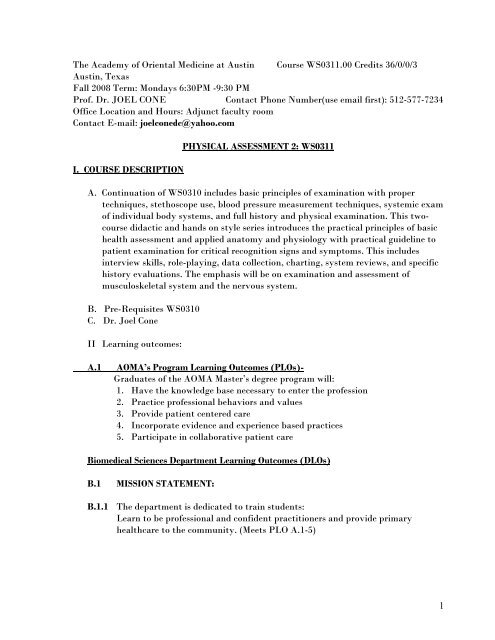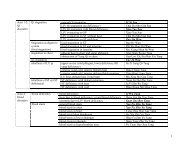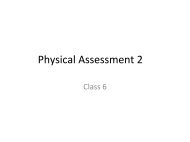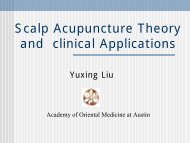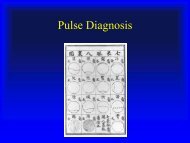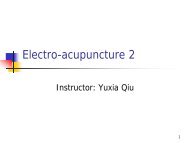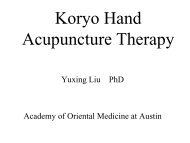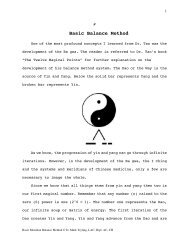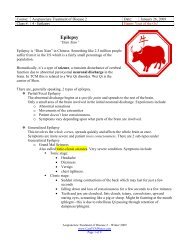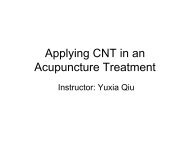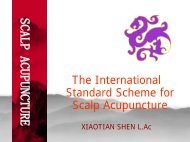Syllabus.pdf - CatsTCMNotes
Syllabus.pdf - CatsTCMNotes
Syllabus.pdf - CatsTCMNotes
You also want an ePaper? Increase the reach of your titles
YUMPU automatically turns print PDFs into web optimized ePapers that Google loves.
The Academy of Oriental Medicine at Austin Course WS0311.00 Credits 36/0/0/3Austin, TexasFall 2008 Term: Mondays 6:30PM -9:30 PMProf. Dr. JOEL CONE Contact Phone Number(use email first): 512-577-7234Office Location and Hours: Adjunct faculty roomContact E-mail: joelconedc@yahoo.comI. COURSE DESCRIPTIONPHYSICAL ASSESSMENT 2: WS0311A. Continuation of WS0310 includes basic principles of examination with propertechniques, stethoscope use, blood pressure measurement techniques, systemic examof individual body systems, and full history and physical examination. This twocoursedidactic and hands on style series introduces the practical principles of basichealth assessment and applied anatomy and physiology with practical guideline topatient examination for critical recognition signs and symptoms. This includesinterview skills, role-playing, data collection, charting, system reviews, and specifichistory evaluations. The emphasis will be on examination and assessment ofmusculoskeletal system and the nervous system.B. Pre-Requisites WS0310C. Dr. Joel ConeII Learning outcomes:A.1 AOMA’s Program Learning Outcomes (PLOs)-Graduates of the AOMA Master’s degree program will:1. Have the knowledge base necessary to enter the profession2. Practice professional behaviors and values3. Provide patient centered care4. Incorporate evidence and experience based practices5. Participate in collaborative patient careBiomedical Sciences Department Learning Outcomes (DLOs)B.1 MISSION STATEMENT:B.1.1 The department is dedicated to train students:Learn to be professional and confident practitioners and provide primaryhealthcare to the community. (Meets PLO A.1-5)1
B.1.2 The student will demonstrate ability to integrate and apply basic concepts ofhuman health and disease from western medical knowledge base. (Meets PLOA.1-3, 4)B.1.3 The student will apply knowledge of human anatomy & physiology,pathophysiology, pharmacology, diagnostic data review, clinical assessmenttechniques, and treatments. (Meets PLO A.1.-3, 4, 5)B.1.4 Upon completion of the Biomedical Programs of the course, they will have abasic understanding of principles of:• Human body structure and function• Pathophysiological changes that occur in specific disease conditions• Analyze and understand implications of various western diagnostic data andresults that are applicable to the particular patient• Have a clear understanding of basic western pharmacology, drug classes,their usage, important drug-drug-herb interactions, and their implications inTCM therapy• Develop clear concepts of Current Medical Diagnoses Treatment andPrognostic implications of patient care and management.• Develop clear concepts of documenting and recognizing the benefits ofevidence and experience based medicine. (Meets PLO: A.1- 1-5)•B.1.5 This will be achieved by the learner’s ability to demonstrate an understanding ofthe western disease model and current management strategies available in thesystems of healthcare in US.(Meets PLO: A.1.-5)B.1.6 The learner will be able to apply the skills and knowledge acquired by the coursein the student clinic work and will be able to recognize medical conditions whichmay require immediate hospital/physician referral.(Meets PLO: A.1- 2, 3)Course Learning Objectives (CLOs):Upon completion of this course, students will be able to:C.1 Prepare legible, comprehensive, and focused patient workups that include asuccinct, comprehensive, and unified list of the patient’s medical history.C.2 Analyze the data in the patient workup to determine the probable organ systemthat needs assessment.2
C.3 Document and chronologically organize data, without repetition, omission, orextraneous information.C.4 Demonstrate proficiency in inspection, palpation, percussion and auscultationtechnique applicable to head and neck, thoracic, and abdominal examinations.C.5 Perform physical examination with particular emphasis on musculo-skeletalsystem. Demonstrate documentation of ROM, assessment of joint disability, anddifferentiation between neurological and muscular disorders affecting muscles.(Meets DLO: B.1.3, B.1.5)C.6 Critically evaluate functions of cranial nerves, motor and sensory systems, andidentify the anatomical and physiological location of the pathology. (MeetsDLO: B.1.3, B.1.5)C.7 Determine whether the patient needs a ‘short focused’ physical exam or adetailed ‘full physical’ exam.C.8 Perform an allopathic approach physical examination, so that patients will getthe benefits of holistic medicine and be able to determine if crisis caremanagement is required.C.9 Identify and explain signs and symptoms indicating a need for referral toappropriate healthcare providers. (Meets DLO: B.1.4, B1.5, B.1.6)C.10 Communicate in a professional, knowledgeable manner with other healthcareworkers in order to enhance the benefits of TCM therapy. (Meets DLO: B.1.4,B1.5, B.1.6)III.COURSE TEXTBOOKSA. REQUIRED:Bickley, L. S. & Szilaygi, P.G. (2007). Bate’s Pocket Guide to PhysicalExamination and History Taking (5 th ed). Philidelphia: Lippincott.ISBN: 0781793483This book is the most comprehensive up to date book published. It has step bystep approach to learn the physical assessment and history taking techniques. Itwill serve as a good reference book for use in your practice. It fits your lab coatpocket!Recommended:Bates' Guide to Physical Examination and History Taking, 9th EditionLynn S. Bickley, MDPeter G. Szilagyi, MD, MPHISBN: 0-7817-6718-0Special Tests for Orthopedic Examination, 3 rd EditionJeff J Konin, Denise L Wiksten, Jerome A Isear, Jr., Holly BraderISBN-10 1-55642-741-7EQUIPMENT REQUIRED:1. Flashlight or Penlight2. Tape Measure3
A. Class Attendance, Tardiness, Leaving EarlyStudents are expected to be on time and prepared for the day’s lesson. Furthermore,class participation is required, as is a courteous and polite manner. Strict adherenceto the Student Handbook and AOMA policies will be kept.Attendance is mandatory. Since this is clinical practical course, a student may missup to one, three-hour sessions without penalties. If a student misses more than whatis permissible, regardless of the reason, the final course grade will be lowered oneletter. If a student misses more than 25 % of the scheduled classes, the student willbe dropped from the course as of that date, and the course grade will be determinedas stated in the add/drop policy. (See the latest student manual.)Three tardiness or early departures will be counted as an absence and willbe subject to the stated attendance policies.If a student misses an exam, the individual must make it up within 7 calendar days.Please contact the administration office to set up the date for making–up the examand to pay the make – up fee. Please read Student Manual 2007-2008 for details.B. Plagiarism and CheatingPlagiarism and cheating are serious offenses of academic and public life. Blatant orintentional plagiarism occurs when a person copies a passage almost word for wordwithout identifying the source of the words or ideas. Unintentional plagiarismoccurs when a person attempts to paraphrase the words of another, but the sentencestructure, sequence of ideas, and key phrases noticeably resemble the originalwithout giving due credit to the author.Cheating is looking at or copying unauthorized sources during an in-class quiz, test,or exam, or during a take-home exam or assignment. It may also includeunauthorized submission of a paper or assignment used for another class.Faculty may impose the following consequences:Blatant Plagiarism: May mean (at the discretion of the professor) failure in thecourse.Unintentional Plagiarism: May (at the discretion of the professor) result in anautomatic “F” for the assignment and may require that, in order to receive creditfor the course, the student repeat the assignment (without credit) using properdocumentation.Cheating: May result in an “F” for the assignment. It may also result in failure ofthe course and any other action deemed appropriate by the professor, division chair,and Provost.5
Repeated Plagiarism or Cheating: May result in academic suspension from theacademy by the Academic Council. Faculty must report all incidences of plagiarismor cheating to the Academic Office.C. Late Work PolicyIn rare emergency students can turn in assignment after the time it is due. Thefinal grade for the assignment will be docked at least one letter grade for the latework.D. Electronic Submission PolicyElectronic submissions are not acceptable. Only hardcopies are admissible forassignments.E. Email Communication Policy1. Contact outside of class. If you have any concerns or questions please contact meby email.2. I try to respond to all my emails as soon as possible, almost always I am able toreply within 24 Hours if I am in town Monday through Thursday.3. The best time(s) to contact me is Monday through Thursday.4. My office hours are Wednesdays and Fridays 12:45 pm-1:45 pm during the courseweeks.F. Scholarship of Engagement AgreementAs a learning institution, AOMA engages in classroom research on the effectivenessof teaching. It is understood that all student work and grades may be anonymouslyused in the study of the scholarship of teaching and learning. Any student notwishing to participate in this learning endeavor should make his or her wishesknown to the professor within the first two weeks of the course.G. Shared Responsibility for LearningStudents are expected to be actively engaged with the learning process. Bothinstructor and students have responsibilities to be active participants in the learningthat occursH. Returning Quizzes, Examinations will not be returnedIf there is a question the student is encouraged to make an appointment with theinstructor for individual discussionI. Accommodation for Special NeedsIf you need special accommodations because of a documented disability, whether itis a physical, sensory or learning, you must process your request with the Dean ofStudents.6
Contact should be made prior to the beginning of the term (the sooner the better), toallow enough time to review the disability documentation and to arrange for anyneeded reasonable accommodations. If contact is not made prior to the beginning ofthe term accommodations may not be possible.J. Classroom DecorumStudents are expected to be on time and prepared for the day’s lecture. Classparticipation is expected, as well as courteous and polite manners. Students areexpected to develop knowledge introduced in class on their own time. Homeworkassignments are designed to exercise the concepts presented and provide workingknowledge of the information presented.SELECT BIBLIOGRAPHYA. Recommended Current and Classics:Author: Robert J. Lederman, How to Be a Truly Excellent Junior MedicalStudent (6E) Paper Back 124 pp, Tarascon Publishing ISBN 1882742125,(July 2002)B. Journal articlesNew England Journal of Medicine – Library archival researchC. Key Web Resources:http://ejournals.ebsco.com/login.asp?bCookies=Falsehttp://medicine.ucsd.edu/clinicalimg/Links.html(An excellent source for all image data you want to review on any topic inBiomedicne field)I highly recommend checking outhttp://library.med.utah.edu/neurologicexam/html/introduction.htmlIt is an excellent source of material (which some was borrowed for this class)and has interactive explanatory videos of a lot of interesting material relatedto physical assessment.7


